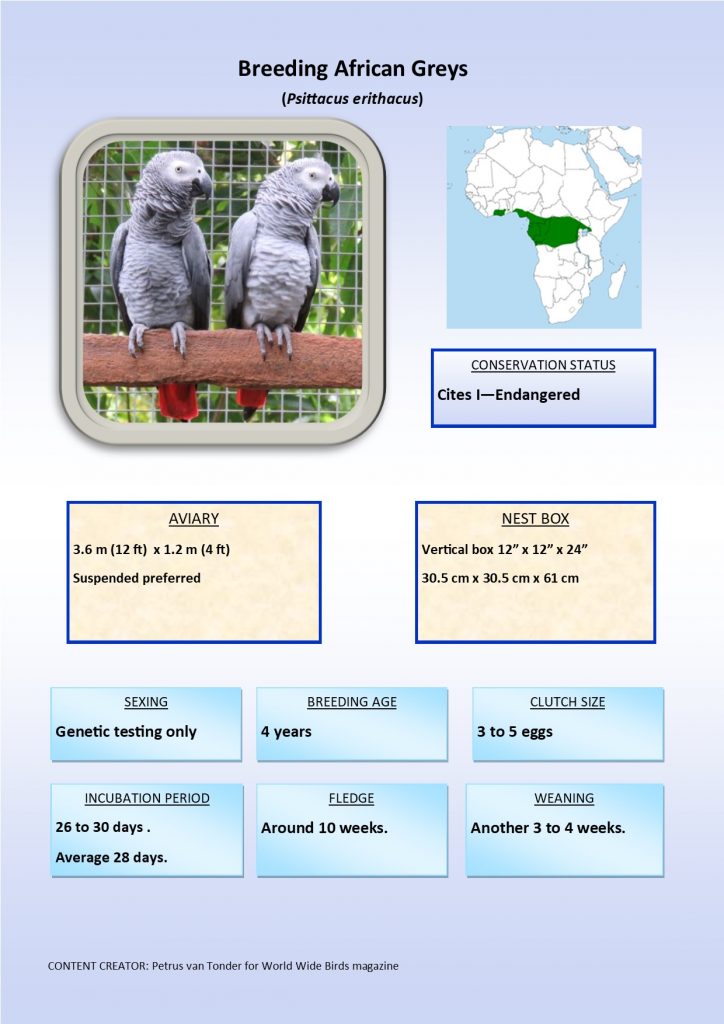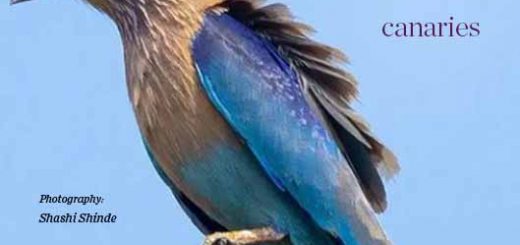Breeding African Greys infographic: Nest box
Breeding African Greys infographic: Breeding African Grey parrots requires careful planning, dedication, and knowledge about their specific needs and behaviors. African Greys are intelligent and sensitive birds, so providing the right environment and care is crucial for successful breeding.
Key Considerations for Breeding African Greys
1. Pair Selection:
- Compatibility: Ensure the pair is compatible and bonded. African Greys can be selective about their mates, so it’s essential that the birds show signs of mutual affection and comfort.
- Age: Breeding African Greys should be mature, typically between 4 to 6 years old. Younger birds may not be ready to breed, while older birds may face health challenges.
- Health: Both birds should be in excellent health. A pre-breeding health check by an avian veterinarian is advisable.
2. Breeding Environment:
- Cage Setup: Provide a spacious breeding cage, typically at least 3 feet by 2 feet by 3 feet. The cage should have a nest box attached. The nest box should be secure, dark, and large enough for the female to lay and incubate eggs comfortably.
- Nest Box: The nest box dimensions should be approximately 12 inches by 12 inches by 18 inches. Line it with safe, non-toxic nesting materials like wood shavings or shredded paper.
- Privacy: African Greys prefer privacy during breeding. Place the breeding cage in a quiet, low-traffic area of your home.
3. Diet and Nutrition:
- Balanced Diet: Provide a diet rich in calcium, protein, and other essential nutrients. A mix of high-quality pellets, fresh fruits, vegetables, and seeds is recommended.
- Supplements: Calcium and vitamin D3 supplements can help prevent egg binding and support healthy egg production. Offer cuttlebone or mineral blocks in the cage.
- Egg-Laying: Once egg-laying begins, ensure the female has access to soft foods like cooked eggs, soaked seeds, and sprouted grains.
4. Breeding Process:
- Courtship Behavior: Watch for courtship behaviors like feeding each other, mutual preening, and mating calls. These are signs that the pair is ready to breed.
- Egg Laying: The female typically lays 2 to 4 eggs, one every other day. She will start incubating after the second or third egg is laid. Incubation lasts about 28 to 30 days.
- Male Role: The male will feed the female during incubation. Ensure the male has access to ample food.
5. Incubation and Hatching:
- Monitoring: Regularly check the nest box, but do so discreetly to avoid disturbing the pair.
- Hatching: Chicks will start hatching around 28 to 30 days after incubation begins. They are born blind and featherless, relying entirely on their parents for warmth and food.
- Feeding Chicks: The parents will feed the chicks regurgitated food. Ensure they have plenty of high-quality food available.
6. Raising Chicks:
- Hand-Rearing (Optional): Some breeders choose to hand-rear chicks for taming purposes. If you opt for this, remove the chicks from the nest at around 3 to 4 weeks old and begin hand-feeding.
- Weaning: Chicks will start weaning at around 10 to 12 weeks old. Offer soft foods like soaked pellets and mashed fruits and vegetables during this period.
7. Socialization:
- Interaction: Whether hand-reared or parent-reared, it’s essential to interact with the chicks to ensure they become well-socialized pets.
- Environment: Provide a stimulating environment with toys and perches to encourage physical and mental development.
8. Health Monitoring:
- Regular Checks: Keep a close eye on the health of the breeding pair and the chicks. Look out for signs of illness or stress and consult an avian vet if needed.
- Parasite Control: Ensure the environment is clean and free from parasites that could harm the birds.
Challenges and Considerations:
- Stress: Breeding can be stressful for African Greys. Monitor their behavior closely to ensure they are coping well.
- Egg Binding: This is a serious condition where a female is unable to lay an egg. Immediate veterinary intervention is required if suspected.
- Legal Requirements: Ensure you are aware of any legal requirements regarding breeding African Greys in your region, as they are a CITES-listed species, and breeding may be regulated.
Breeding African Greys infographic: Conclusion:
Breeding African Grey parrots is a rewarding but demanding endeavor. By providing the right environment, nutrition, and care, you can help ensure the health and success of both the breeding pair and their offspring. Always be prepared to consult with an avian veterinarian or an experienced breeder if you encounter any challenges.
Breeding African Greys infographic
Breeding African Greys infographic: I designed the below infographic to highlight key information when breeding African Greys.
African greys are endangered and are listed as Cites I. To breed and export them for commercial purposes, very strict regulations apply.
I did not include information on feeding as this topic needs an infographic of its own. The deficiencies of any nutrients can lead to a suppression of the immune system and reduced fertility. Your birds need a complete nutrient-rich diet that also includes fresh vegetables and/or fruit. It is possible to give too many supplements that can result in toxicosis and /or organ damage. Too much protein can also have a negative effect on your bird’s health and fertility. Toxic ingredients like avocado and chocolate should be avoided.
Breeding African Greys infographic: Five categories of a birds diet:
Category 1 – Vitamins and minerals
Category 2 – Protein
Category 3 – Carbohydrates
Category 4 – Vegetables and Fruits
Category 5 – Fats
You can download the infographic that covers these categories at:
A bird’s diet is the most important aspect to keep them healthy. You can also refer to the following blog post for more information on diet: (A infographic is available on this blog post to download.)
https://www.wwbirds.co.za/dir/avian-health-care-tips/

Photo courtesy: Tony Silva Map Courtesy: Wikipedia
You might also be interested in the following two blog posts:
https://www.wwbirds.co.za/dir/do-african-grey-parrots-need-dark-cages-to-breed/
https://www.wwbirds.co.za/dir/breeding-of-african-greys-part-1-by-tony-silva/
I hope that this infographic about breeding African Greys is helpful and please leave a comment for the improvement of future infographics.
Content creator: Petrus A. van Tonder



Wow, this is fantastic 🙂 Thank you very much for the great work.
Thank you Nicole. It took some time to create and glad you find it informative.